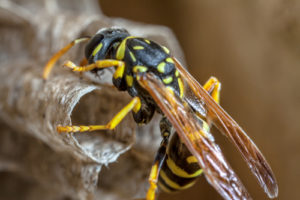Common Name: Paper Wasps
Scientific Name: Polistes spp.
Class/Order/Family: Insecta/Hymenoptera/Vespidae
Metamorphosis: Complete
Introduction
Paper wasps get their co mmon name from the paperlike material of which they construct their nests; true also of the other vespids. It has been suggested that they be called umbrella wasps based on the shape of their nests. In the urban situation, these usually unaggressive wasps are a nuisance pest. Various species are found throughout the United States.
mmon name from the paperlike material of which they construct their nests; true also of the other vespids. It has been suggested that they be called umbrella wasps based on the shape of their nests. In the urban situation, these usually unaggressive wasps are a nuisance pest. Various species are found throughout the United States.
Recognition
Adults about 5/8-3/4″ (16-20 mm) long. Color brownish with yellow markings, a few species with reddish markings. Head with clypeus (upper lip) usually pointed at apex. Pronotum in lateral view almost triangular, extending to tegulae (structure at base of front wing) or nearly so. Long-legged, middle tibia with 2 apical spurs. Hind wing with small jugal lobe (lobe on rear near body). 1st abdominal segment conical, not stalklike.
Similar Groups
(1) Yellowjackets and hornets (subfamily Vespinae) with clypeus (upper lip) broadly truncate and slightly notched at apex, hind wing lacks jugal lobe (lobe on rear near body). (2) Potter and mason wasps (subfamily Eumeninae) have middle tibia with 1 apical spur. (3) Spider wasps (Pompilidae) have mesopleura (side of mesothorax) with a transverse suture (impressed line), hind wing with a jugal lobe.
Representative Species
1. Golden paper wasp, Polistes fuscatus aurifer Saussure. Length about 5/8-3/4″ (16-20 mm); black with face and most of abdomen bright yellow; thorax with 6 narrow yellow stripes, yellow margin on 1st abdominal segment; found in Connecticut, New York, New Jersey, Maryland, Delaware, southeastern U.S., Texas, and South Dakota. 2. Polistes annularis (linnaeus). Length about 3/4″ (18 mm); Blackish brown with bright yellow margin on 1st abdominal segment; found in Connecticut, New York, New Jersey, Maryland, Delaware, southeastern U.S., Texas, and South Dakota. 3. Polistes apachus Saussure. Length about 3/4″ (20 mm); golden brown with yellow markings, pronotum bordered with thin yellow stripe, mesonotum with 2 transverse stripes (anterior narrow, posterior broad). Abdomen with alternating stripes of golden brown and yellow; found in southern California and in Texas and adjacent regions. 4. Polistes dorsalis dorsalis (Fabricius). Length about 3/4″ (17-18 mm); reddish brown with 1st abdominal segment narrowly outlined with yellow, tarsi yellow; found in southeastern U.S., Missouri, Kansas, Colorado, Oklahoma, Texas, and New Mexico.
Biology
Paper wasps are semi-social, existing in small colonies but without a worker caste. Overwintering inseminated queens begin building nests in the spring. These founding queens are often joined by other inseminated queens which assist in nest building and maintenance. Such secondary queens become functional workers and relegate egg laying to the founding queen. However, should the founding/dominant queen die, one of the secondaries can assume egg laying and assure that the nest will survive. Nests consist of a single layer of paperlike comb with the cells opening downward. This comb is supported/suspended from a branch, twig, or horizontal surface by a single long pedicel; this single, long pedicel apparently aids in the defence of the nest by predators such as ants. This comb is never enclosed by an envelope, but remains naked. A single egg is laid in each cell and the developing larva is fed primarily protein from insect prey through the open cell. The cell is capped when the larva is ready to pupate. Nests are small to moderate in size, containing up to about 150-250 cells; largest contained 320 cells and was 6×8″ (15×20 cm) in size.
Habits
Paper wasps hang their comb nests from twigs and branches of trees and shrubs which can cause concern when ornamental shrubs and hedges are trimmed or fruit is being picked from trees. If a nest is contacted, there is high probability the person doing the trimming or fruit picking will get stung. Paper wasps also like to hang their comb nests from porch ceilings, the top member of window and door frames, soffits, eaves, attic rafters, deck floor joints and railings, etc., almost any protected place imaginable.
Control
Paper wasps are beneficial insects, helping to control many insect pests. If their nest is located near human activity, control is warranted. It is essential that the adults be contacted and killed or they will quickly rebuild. For adults, use an appropriately labelled pesticide such as aerosol pyrethrins or a pyrethroid and do the application early in the morning or at night when most of the wasps will be on the nest. Then remove the nest. Before trimming shrubs or hedges or picking fruit, check the plant for paper wasp nests and treat and remove any found before proceeding. Be careful that the pesticide used will not harm the plant involved.